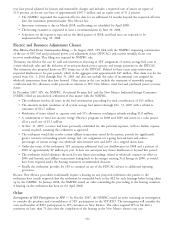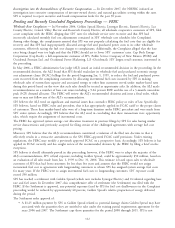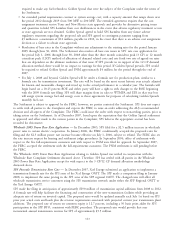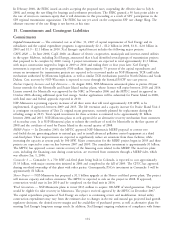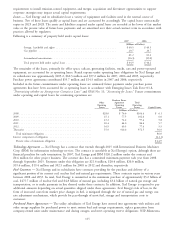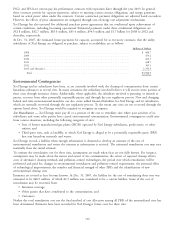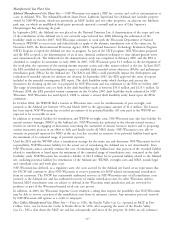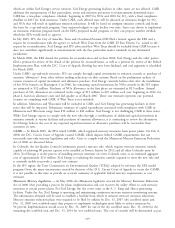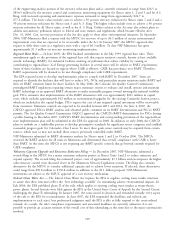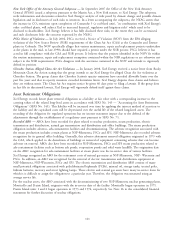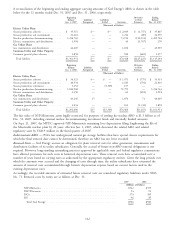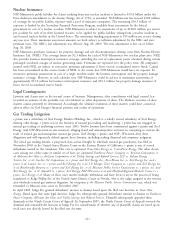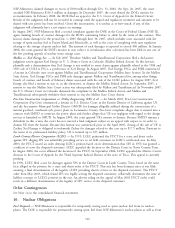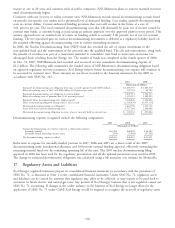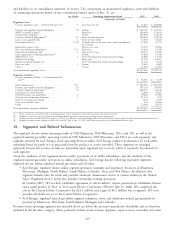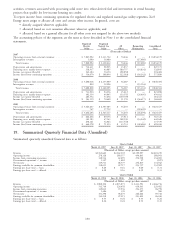Xcel Energy 2007 Annual Report Download - page 130
Download and view the complete annual report
Please find page 130 of the 2007 Xcel Energy annual report below. You can navigate through the pages in the report by either clicking on the pages listed below, or by using the keyword search tool below to find specific information within the annual report.of the engineering analysis portion of the mercury reduction plans and is currently estimated to range from $26.5 to
$854.5 million for the mercury control and continuous monitoring equipment for Sherco units 1, 2 and 3 and for A.S.
King, with increased operating and maintenance expenses estimated to range from approximately $24.7 to
$77.2 million. The lower values include costs to achieve a 50 percent mercury reduction for Sherco units 1 and 2 and a
90 percent mercury reduction for Sherco unit 3 and A. S. King. The higher values include costs to achieve a 90 percent
mercury reduction for all Sherco units, as well as for A. S. King. Utilities subject to the Act may also submit plans to
address non-mercury pollutants subject to federal and state statutes and regulations, which became effective after
Dec. 31, 2004. Cost recovery provisions of the Act also apply to these other environmental initiatives. In September
2006, NSP-Minnesota filed a request with the MPUC for recovery of up to $6.3 million of certain environmental
improvement costs that are expected to be recoverable under the Act. In January 2007, the MPUC approved this
request to defer these costs as a regulatory asset with a cap of $6.3 million. To date NSP-Minnesota has spent
approximately $1.3 million on mercury monitoring implementation.
Regional Haze Rules — In June 2005, the EPA finalized amendments to the July 1999 regional haze rules. These
amendments apply to the provisions of the regional haze rule that require emission controls, known as best available
retrofit technology (BART), for industrial facilities emitting air pollutants that reduce visibility by causing or
contributing to regional haze. Xcel Energy generating facilities in several states will be subject to BART requirements.
Some of these facilities are located in regions where CAIR is effective. CAIR has precedence over BART. Therefore,
BART requirements will be deemed to be met through compliance with CAIR requirements.
The EPA required states to develop implementation plans to comply with BART by December 2007. States are
required to identify the facilities that will have to reduce SO2, NOx, and particulate matter emissions under BART and
then set BART emissions limits for those facilities. In May 2006, the Colorado Air Quality Control Commission
promulgated BART regulations requiring certain major stationary sources to evaluate and install, operate and maintain
BART technology or an approved BART alternative to make reasonable progress toward meeting the national visibility
goal. PSCo estimates that implementation of the BART alternatives will cost approximately $211 million in capital
costs, which includes approximately $62 million in environmental upgrades for the existing Comanche Station project,
which are included in the capital budget. PSCo expects the cost of any required capital investment will be recoverable
from customers. Emissions controls are expected to be installed between 2011 and 2014. On June 4, 2007, the
CAPCD approved PSCo’s BART analysis and obtained public comment on its BART determination and PSCo’s BART
permits. The Air Quality Control Commission (AQCC) approved the CAPCD’s BART determination for PSCo during
a public hearing in December 2007. CAPCD’s BART determinations and corresponding provisions of the regional haze
state implementation plan will be submitted to the EPA for approval in 2008. In addition, in early 2008, the CAPCD
plans to embark on a stakeholder process to develop presumptive standards for significant source categories and establish
reasonable progress goals for Colorado’s Class I areas. To meet these goals, more controls may be required from certain
sources, which may or may not include those sources previously controlled under BART.
NSP-Minnesota submitted its BART alternatives analysis for Sherco units 1 and 2 in October 2006. The MPCA
reviewed the BART analyses for all units in Minnesota and determined that overall, compliance with CAIR is better
than BART. At this time, the MPCA is not requiring any BART specific controls that go beyond controls required for
CAIR compliance.
Voluntary Capacity Upgrade and Emissions Reduction Filing — In December 2007, NSP-Minnesota submitted a
revised filing to the MPUC for a major emissions reduction project at Sherco Units 1and 2 to reduce emissions and
expand capacity. The revised filing has estimated project costs of approximately $1.1 billion and encompasses the higher
value mercury control costs discussed above in the Minnesota Mercury Legislation section. The filing also contains
alternatives for the MPUC to consider additional capacity and to achieve lower emissions. If selected, these alternatives
could range from $90.8 million to $330.8 million in addition to the $1.1 billion proposal. NSP-Minnesota’s
investments are subject to the MPUC approval of a cost recovery mechanism.
Federal Clean Water Act — The federal Clean Water Act requires the EPA to regulate cooling water intake structures
to assure that these structures reflect the ‘‘best technology available’’ for minimizing adverse environmental impacts. In
July 2004, the EPA published phase II of the rule, which applies to existing cooling water intakes at steam-electric
power plants. Several lawsuits were filed against the EPA in the United States Court of Appeals for the Second Circuit
challenging the phase II rulemaking. In January 2007, the court issued its decision and remanded virtually every aspect
of the rule to the EPA for reconsideration. In June 2007, the EPA suspended the deadlines and referred any
implementation to each state’s best professional judgment until the EPA is able to fully respond to the court-ordered
remand. As a result, the rule’s compliance requirements and associated deadlines are currently unknown. It is not
possible to provide an accurate estimate of the overall cost of this rulemaking at this time due to the many uncertainties
involved.
120



